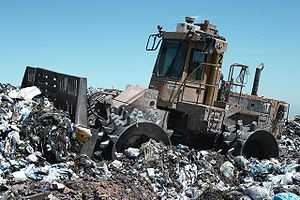Waste compaction
Waste compaction is the process of compacting waste, reducing it in size. Garbage compactors and waste collection vehicles compress waste so that more of it can be stored in the same space. Waste is compacted again, more thoroughly, at the landfill to conserve valuable airspace and to extend the landfills life span. A side effect of this is that important items, like evidence in a crime, may be difficult to recover from the garbage. Due to reduced oxygenation, biodegradation of organic waste is also slowed.
Consumer & post-collection compaction
Pre-landfill waste compaction is often beneficial, both for people disposing of waste and the company collecting it. This is because waste collection companies frequently charge by volume or require use of standard-volume containers, and compaction allows more waste to fit in the same space. Trash compactors are available for both residential and commercial use. Compacting garbage after is collected allows more waste to fit inside the collection vehicle, meaning fewer trips to a dump or transfer station are required. The collection company also incurs lower landfill fees, if the landfill charges by volume.[1]
Landfill compaction

A landfill compaction vehicle has two main functions: to spread the waste evenly in layers over the landfill, and to compact waste to reduce its volume and help stabilize the landfill. Proper waste compacting includes the process of using a steel wheeled/drum landfill compactor to shred, tear and press together various items in the waste stream so they consume a minimal volume of landfill airspace. The higher the compaction rate, the more trash the landfill can receive and store. This will also reduce landslides, cave-ins and minimize the risk of fire.
Main compaction is produced by the landfill compactors steel tooth on the wheel drums. Special teeth can penetrate the waste and deliver a focused compression point, providing compaction and increased density. Ground pressure of the tooth can exceed over 4000 PSI. The design of the machine and more importantly the wheels and the teeth is very critical in compaction. The steel wheels should be as wide as possible and have as many teeth as possible. Small wheel only spreads the waste, but large compactor drum can compact, tear and shred the waste, creating a nice even compacted surface.
